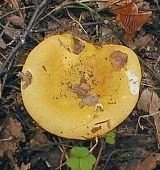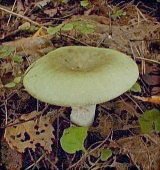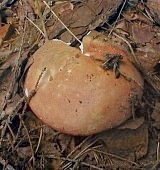 |
HISTORY OF MYCOLOGY IN LATVIA |
|||||||||||||||||||||||||||||||||||||||||||||||||||||||||||||||||
|
|
Latvia's top mycologist for so many decades, Edgars Vimba, Dr.biol.passed away peacefully at the age of 95 on August 27, 2025. His scientific carrier will remain an indispensable part in the history of Latvia's mycology. Currently in this chapter: ● History of the Investigations of the Mycobiota of Latvia ● Ferdinand Erdmann Stoll – ornithologist and mycologist ● Arnolds Amolins' historic Key of Latvian Russulas (2005)
History of the Investigations of the Mycobiota of Latvia Chronology of research till the middle of the 20th century Edgars Vimba This paper is mainly devoted to mycological studies in Latvia, but historically there was a strong link between mycological and phytopathological investigations. Therefore, the paper includes also some data on phytopathological studies in Latvia. The first data on mycobiota of Latvia were published in the monograph written by J. B. Fischer “Versuch einer Naturgeschichte von Livland” (1778). Second, already revised edition was published in 1791. Data on fungi were published by other authors as well (Grindel, 1803; Friebe, 1805). In 18th and 19th century and at the beginning of 20th century data on mycobiota of Latvia and Estonia are usually given together as part of Estonia was included in Livonia. So in the first books on nature in Baltic (Fischer, 1778.1884, 1791) the data are from the territories of Latvia and Estonia; In 1845 Society of Riga`s Naturalists (Naturforscher-Verein zu Riga) was founded. This society played an important role in mycological investigations of Latvia. Members of this society on scientific meetings informed about their findings. K. A. Merklin published a paper on potato blight (Merklin, 1848; 1856; Мерклин, 1848). It was the first time when potato blight was found in Latvia. The paper written by J. H. Kawall on Latvian vernacular names of mushrooms was published in the journal “Magazin” in 1866. In this period little articles on fungi were published by Buhse (1851, 1856), Loevis of Menar Lipskaln, 1884; Meyer, 1889; Vangenheim von Qualen, 1854.) W. Rothert published an article on myxomycetes of Riga’s surroundings (1890), but later - on sclerotia on Melampyrum pratense (Rothert, 1898; 1899; 1900). In 1862 Riga Polytechnic Institute was founded, where phytopathological studies were carried out at the Agricultural Department. From 1897 to 1915 prof. F. Bucholtz gave courses in Botany and Zoology in this Department and studied fungi hypogaei. F. Bucholtz published many papers on development, morphology and distribution of this group of fungi ( Bucholtz, 1901a;1901b; 1901c; 1901d; 1902; 1903; 1905c; 1907;1912; 1922; Бухгольц. 1902; 1910; 1911). F. Bucholtz also published papers on other groups of fungi, such as, genus Boletus (Bucholtz, 1904a), rust fungi (Bucholtz, 1905a, 1905b), peronosporales (Bucholtz, 1909), myxomycetes (Bucholtz, 1908) and Claviceps purpurea (1904b). Some of these papers were written together with other specialists or students. So in 1903 with A.Bondarzew as a co-author the article on parasitic fungi found in surroundings of Riga in summer 1903 was published (Бухгольц, Бондарцев, 1903; Bondarzew, Bucholtz, 1903; Бондарцев, 1903)). Some papers published in this time considered causal agents cultivated and wildgrowing plants (Bucholtz, 1904b; Bucholtz, 1904c; Ferle, 1912). S.Bazarewski published an article on fungus cultivated together with bacteria in tee (Bazarewski, 1915). Together with A. Bondarzev F. Bucholtz edited exsiccate of fungi of Russia (Fungi rossici exsiccati). This exsiccate was edited in two series: A and Б. Series A comprised specimens of common and widespread fungi, mainly causal agents of cultivated plants, but series Б –specimens of rare parasitic fungi and causal agents of wild growing and cultivated plants. Both series comprised materials from Baltic and from Latvia. Till 1918 eight volumes were prepared; four volumes from every series. I, II, and XII were prepared by prof F. Bucholtz, others - with A. Bondarzev as a co-author (Bucholtz, 1915-1918; Бухгольц, 1915; 1916; Бухгольц, Бондарцев, 1917). This exsiccata contained 900 species of fungi. J. Bickis – a student of prof. F. Bucholtz graduated Riga Polytechnic Institute in 1910 with Diploma work “Surwey Peronosporales of the Baltic region, especially potato blight”. Later on J. Bickis was a chief of Priekuļi Agricultural School. In 1913 he organized the Baltic Station for pests control of Cultivated Plants. In 1914 this Station was renamed the Baltic Bioentomological Station. The station developed as a centre not only for entomological, but also myco- and phytopatological investigations of Latvia. He published several issues on fungi - causal agents of cultivated plants (Bickis, 1915; 1918a; 1918b) From the beginning of the 20th century in periodical editions scientific popular articles on plant diseases written by J. Smarods have been published (Smarods, 1908; 1911). J. Smarods collected mycological materials and sent them for determination to outstanding Russian mycologist A. Jachewski. Later on such a successful collaboration was with F.Bucholtz's student A. Bondarzev. During the World War I J.Smarods continued collecting mycological materials even being on the front in Galicia. From the mycologists of the beginning of the 20th century L. Arefjev must be mentioned. He published two articles: “Species of the genus Uromyces of the Baltic region” and “Species of the genus Puccinia of the Baltic region” ( Арефьев, 1916, 1917). Last article was devoted to the species of the genus Puccinia on Gramineae (Poaceae) and Cyperaceae. In this period also results of investigations carried out by A. Grosse on Sclerotinia pyrolae (Grosse, 1912) and V. Pashkin on Sclerotinia root rot of clover were published (Пашкин, 1916). Activities of the Baltic Bioentomological Station especially took place after World War I when the office was moved to Riga and M. Eglītis became the chief of the station. Meanwhile, J. Bickis become a docent of the University of Latvia. In 1923 the station was renamed the Latvian Institute for Plant Protection. J. Smarods started to work in Latvian Institute for Plant Protection in summer 1922. His data on mycobiota and causal agents of diseases of cultivated plants of Latvia were published annually in 1920-ies. ( Anonīms,1924.b, 1926., 1927., 1928.,1929., Smarods, 1923a, 1923b, 1923c,1923d, 1924a, 1925,).P.Pētersons studied diseases of trees and shrubs (Anonīms, 1924a). In 1928 the Keybook for determination of parasitic fungi was published. (Eglītis, 1928). In 1930 A. Ķirulis started to work at the institute. Later A. Ķirulis was a docent in Agricultural Academy in Jelgava. His mycological herbarium is now kept at the Latvian Agricultural University in Jelgava at the Institute of Soil and Plant Science. Part of his herbarium has disappeared during the World War II. He published articles on rare and interesting species of fungi (Ķirulis, 1935a, 1935b, 1938). Kārlis Starcs was a botanist working at this Institute from 1923. He collected herbarium of flowering plants, ferns, lichens and fungi as well. At present time this herbarium is found at the Faculty of Biology of University of Latvia. K. Starcs had a close co-operation with German mycologist A.Ludwig. The first volume of scientific novelties of the researchers of the Latvian Institute for Plant Protection was published in 1930, but the second - in 1932. In both volumes along the papers on phytopathological problems mycological data of J. Smarods were published (Smarods, 1930a; 1930b; 1932a; 1932b). His papers were published in other editions as well (Smarods, 1930c, 1930d; 1940b, 1940c; 1940d). From the 1931-1956 J. Smarods edited exsiccata of fungi of Latvia (Fungi latvici exsiccati). Till the 1956 he prepared 27 volumes comprising 1350 specimens. After death of J. Smarods the 28th volume with 50 specimens was prepared by I. Zherbele of the Baltic branch of Allunions Institute for Plant Protection, what was the name of the Latvian Institute for Plant Protection in soviet time, and docent E. Vimba of the Latvian State University (Smarods, 1931-1956; Smarods, 1931-1945). In 30-ies J. Smarods published many articles on mycobiota of Latvia in the journals “Daba”, “Daba un Zinātne:” (Smarods, 1929a;1929b; 1930c 1940a). The textbook by M. Eglītis “Diseases of plants” in was an excellent textbook not only for the phytopathologists, but for the mycologists as well. (Eglītis, 1938).M. Eglītis was a member of the physiological branch of phytopathology in Latvia. I. Peniks studied entomopathogens and diseases of sugar beet (Peniks, 1933). His diploma theses were devoted to the mycobiota of the Botanical Garden of University of Latvia (unpublished). In the University of Latvia A. Apinis studied fungi of
Saprolegniales. He divided family Saprolegniaceae in 3 subfamilies and described 50 new species for
Saprolegniales in Latvia. He also carried out cytological studies of development of reproductive organs and nucleus of fungi of genera
Achlya and Archilegnia. Already during his studies at the University of Latvia A. Apinis received award about his paper “Investigations on water fungi found in
Latvia” (Apinis, 1929; 1933). In the 20-ies and 30-ies macroscopic fungi (mainly Agaricales s.l.) were studied by F. E. Stoll. His book "Latvijas sēnes" (Fungi of Latvia) edited in 1934 was very popular among Latvians this time. His book on plants, animals (mainly birds) and fungi at the seaside of Riga’s Gulf contains interesting and valuable material (Stoll,1931). He has found and described new species Coprinus dunarum Stoll and other publications on mycobiota of Latvia (Stoll 1930a; 1937). Many of his papers on mycobiota of Latvia were published in Germany (Stoll, 1923a; 1923b; 1925; 1926a; 1926b, 1926c; 1927; 1929a; 1929b,. 1930). Especially noteworthy is the collection of his water colour drawings of fungi. The collection consists of 137 volumes (folders?) and has 1100 pages. Every drawing is supplemented by drawings of spores, their measurements, species locality, and Latvian vernacular names of a fungi. In this collection drawings of rare fungi of Latvia, such as Amanita eliae, Amanita excelsa, Poronia punctata, Tulostoma mammosum etc can be found. For a long time the collection was kept at the house of the daughter of F. E. Stoll in Potsdam. In 1998 Katharina Bickerich-Stoll presented this collection to the Faculty of Biology University of Latvia in Rīga. In Proceedings of Society of Riga’s Naturalists are published data on numerous presentations made by F.E.Stoll on scientific sittings on various fungi. Som e papers on fungi are published by H.Skuja (Skuja,1918; Skuja, 1926). Later in 1936 he published survey of mycobiota of Latvia (Skuja, 1936). The outstanding botanist K. R. Kupffer collected fungi as well. In his publication on vegetation of the Moricsala Island the data on fungi he and other collectors had collected on the island were given (Kupffer, 1931). At the beginning of 40-ies A. Ķirulis and K. Starcs prepared and edited the exsiccate of diseases of cultivated plants. The collection comprised 200 specimens. In 1942 A. Ķirulis published results of his studies of microscopical fungi as causal agents of plant diseases. (Ķirulis, 1942). Mycobiota of Latvia was studied by foreign mycologists as well. The Estonian mycologist E. Lepik published a paper on the fungi material collected in Latvia (Lepik,1933); J. Smarods in co-operation with the Hungarian mycologist G. Moesz described about 30 new species of fungi. (Moesz, 1930; 1932;1934; 1937; 1938; 1939; 1941; 1942).J. Smarods name was given to five species of genera Diplodina, Entylomella, Leptosphaeria, Septoria and Valsella. German mycologists H. Sydow and W. Kirschstein described new species of the fungi of Latvia for science (Sydow, 1934, Sydow, 1935. Kirschsteim, 1935; 1944). New species for science was described by Russian mycologist V.N. Bondarceva-Monteverde (1923).
As a result of carried investigations up to the middle of 20th century in Latvia was collected rich herbarium material and published data on hypogeous, macroscopic (mainly
Agaricales s.l.) and microscopic (especially causal agents of plant diseases) fungi. Herbarium, collected by
J. Smarods at present time is located at Latvian Agricultural Institute in Skrīveri, but herbarium collected by
K. Starcs and materials received in exchange at Faculty of Biology of University of Latvia (RIG). References Anonīms (1924a) [P.Pētersons izdarījis koku un krūmu parazitaro sēnīšu pētījumus] (P.Pētersons studied parasitical fungi on trees and shrubs]. Augu Aizsardzības Instituta darbības pārskats par laiku no 1.maija 1923.g. līdz 1.maijam 1924. gadā. 14.-17. Anonīms (1924b) [J.Smarods izdarījis parazītisko sēnīšu floras pētījumus].[J.Smarods caried out investigations of the parasitical flora of fungi] Augu Aizsardzības Instituta darbības pārskats par laiku no 1.maija 1923.g. līdz 1.maijam 1924. gadā.2.-10Anonīms (1926) [J.Smarods apstrādājis materiālus Latvijas mikoloģiskai florai]. [J.Smarods studied material for mycological flora of Latvia]. Augu Aizsardzības Instituta darbības pārskats par laiku no 1.maija 1925.g. līdz 1.maijam 1926. gadā.34.-42. Anonīms (1927) [J.Smarods turpināja apstrādāt materiālus Latvijas mikoloģiskai florai]. [J.Smarods continued study materials for mycological flora of Latvia]. Augu Aizsardzības Instituta darbības pārskats par laiku no 1.maija 1926.g. līdz 1.maijam 1927. gadā.16.-25. Anonīms (1928) Materiali Latvijas mikoloģiskai florai.[ Materials for mycological flora of latvia]. Augu Aizsardzības Instituta darbības pārskats par laiku no 1.maija 1927.g. līdz 1.maijam 1928. gadā. 8.-9. Anonīms (1929) Materiali Latvijas mikoflorai.[Materials for mycological flora of Latvia]. Augu Aizsardzības Instituta darbības pārskats par laiku no 1.maija 1928.g. līdz 1.maijam 1929. gadā. 11.-12 Apinis A.(1929) Untersuchungen ūber die in Lettland gefundenen Saprolegniaceen nebst Bemerkungen über einige andere Wasserpilze. Acta Horti Bot. Univ.Latv. 4(1/3):206-246. Apinis A. (1933) Fertilization of Oospheres by Planogametes in Saprolegniaceae. Acta Horti Bot. Univ. Latv. 8 (1/3):103-121. Bazarewski S. (1915) Über den sogenannten “Wunderpilz” in den baltischen Provinzen. Korr.-Bl. 57: 61-69. Bitcky J. (1915)Labību un citu stiebru augu melnplaukas.[Smuts of the cereals and other plants] Cēsis. 24 lpp. Bickis J. (1918a) Augu slimības un kaitēkļi Diseases and .pests of the plants] Latvijas lauksaimnieks 1918. (4):45-46. Bitcky J. (1918b) Kartupeļu slimības un kaitēkļi[Diseases and pests of the potatos]. Rīgā. 56 lpp. Bondarcev A.S., Bucholtz F. (1903) Pilzparasiten des Sommers 1902 in der Umgebung von Riga. Zeitschr. Pflanzenkr. 13:217-220. Bondarceva-Monteverde V.N. (1923.) De fungo novo in ramulis vivis Equiseti sylvatici. Ботанические материалы Института споровых растений Главного бот. сада РСФСР. 2/2/:18. Briedis A. (1932) Laboulbeniaceae in Latvia. Acta Horti Bot. Univ. Latv. 7(1/3):131-134. Bucholtz F.(1901a) Pseudogenea Vallisumbrosae n.g. et sp. Hedwigia 40:129-130. Bucholtz F.(1901b) Hypogaeen aus Russland. Hedwigia 40:304-322. Bucholtz F.(1901c) Verzeichnis der Hypogaeen aus Russland. Hedwigia 40:304-322. Bucholtz F.(1901d) Verzeichnis der Hypogaeen des Baltikums. Korr.-Bl. 44:1-9. Bucholtz F.(1902) Beiträge zur Morphologie und Systematik der Hypogaeen Russlands. Berlin. Bucholtz F.(1903) Zur Morphologie und Systematik der Fungi hypogaei. Ann.Myc. 1:152-174. Bucholtz F. (1904a) Ūber die Boletusarten der Ostseeprovinzen Russlands. Korr.-Bl.47:29-49. Bucholtz F. (1904b) Bemerkung über das Vorkommen des Mutterkornes in den Ostseeprovinzen Russlands. Korr.-Bl. 47:57-64. Bucholtz F. (1904c) Der Stachelbeermehltau. Balt. Wochenschr. Landw. 42:261. Bucholtz F. (1905a) Die Pucciniaarten der Ostseeprovinzen Russlands. Archiv für Naturkunde Liv-, Ehst- und Kurlands. Jurjev (Dorpat). B.XIII, Lief. 1. 1-60. Bucholtz F. (1905b)Verzeichnis der bisher in den Ostseeprovinzen Russlands bekannt gewordenen Pucciniaaarten. Ann. Myc. 3:437-461. Bucholtz F.(1905c) Nachträgliche Bemerkungen zur Verbreitung der Fungi hypogeii in Russland. Bull.Soc. Natur. Moscou II,18 (4):335-343. Bucholtz F.(1907 (19908)) Zweiter Nachtrag zur Verbreitung Hypogaeen in Russland. Bull. Soc. Imper.Natur., Moscou 21 (4):431-492. Bucholtz F.(1908) Verzeichnis der bisher in den Ostseeprovinzen Russlands bekannt gewordenen Myxogasteres. Korr.Bl.51:93-108. Bucholtz F.(1909). Verzeichnis der bisher für die Ostseeprovinzen Russlands bekannt gewordenen Peronosporineae. Korr.Bl.52:161-172. Bucholtz F. (1912) Beiträge zur Kenntnis der Gattung Endogone Link. Beihefte Bot. Centralbl.29:147-222. Bucholtz F. (1915.-1918) Fungi rossici exsiccati Ser.A, fasc. I-IV. Ser. Б, fasc. XI-XIV. Bucholtz F. (1922) Mycologische Notizen. Sitzungsber. Naturforscher Ges. Tartu 28:10-11. Bucholtz F., Ekmann O. (1919) Über die Verbreitung der Brandpilze (Ustilagineae) in Ostbalticum. Sitzungsber. naturforscher Ges. Dorpat. 26:47-70. Buhse F.A. (1851) Notiz über eine Monstrosität bei Agaricus integer. Corr.Bl.4:110. Buhse F.A. (1886) Über verschiedene Pilze.Korr.Bl.29:1-3. Eglītis M. (1928) Augu slimību noteicējs [Key book for determination of the plant diseases]. Rīga.. 228 lpp. Eglītis M. (1938) Augu slimības [Diseases of the plants]. Rīga. 453 lpp. Ferle Fr. (1912) Verzeichnis parasitischer Pilze, soweit diesselben in den Jahren 1907-1912 vom Verfasser in Livland und Kurland gefunden worden sind. Korr.Bl.55:103-106. Fischer J.B. (1778) Versuch einer Naturgeschichte von Livland. 1 Auflage. Leipzig. S.315-320. Fischer J.B. (1784) Zusätze zu seinem Versuch einer Naturgeschichte von Livland. Riga. S. 149-154. Fischer J.B. (1791) Versuch einer Naturgeschichte von Livland. 2. Aufl. Königsberg. S.667-682. Friebe W.Ch. (1805) Oekonomisch-technische Flora für Liefland, Ehstland und Kurland. Riga. S.295-308. Grindel D.H.(1803) Botanisches Taschenbuch für Liv-,Cur- u. Ehstland. Riga. Grosse A. (1912) Eine neue Sclerotinia Pirolae nov.sp. Ann.Myc.10:387-388. Heugel C.A. (1847) Über das Mutterkorn. Corr.Bl.2:72. Jurevičs B. (1939) Egļu sakņu un stumbru trupe [Spruce root and trunk rot]. Mežsaimniecības rakstu krājums. XVII Rīgā. 81.-108.lpp. Kawall J.H.K. (1866) Pilze in Kurland nach ihren Benennungen und mit versuchter Deuchtung einiger derselber. Magazin 13 (3):77-80. Kirschstein W. (1935). Neue und seltene Ascomyceten. Ann.Myc. 33:202-229. Kirschstein W.(1944) Über neue, seltene und kritische Kleinpilze. Hedwigia 81:193-224. Kupffer K.R. (1931) Die Naturschonstätte Moritzholm. Arbeiten des Naturforschervereins zu Riga. Neue Folge. Heft XIX. S. 76-101. Ķirulis A. (1935a) Egļu galotņu rūsa. Daba un Zinātne. 6:189-190. Ķirulis A. (1935b) Divas interesantas un retas sēnes. Daba un Zinātne. 6:190. Ķirulis A. (1938) Divas ieceļotājas augu slimības.Daba un Zinātne. Nr. 1:27. Ķirulis A. (1942) Mikroskopiskās sēnes kā augu slimību dabīgie ienaidnieki Latvijā. [Microscopical fungi as causal agents of plant diseases in Latvia].Jelgavas LA raksti. Lauksaimniecības fakultāte.1:479-536. Lepik E. (1933) Einige Pilzfunde aus Lettland. Sitzungsber. Naturf. Ges. Univ. Tartu 39:1 69-182. Loewis of Menar Lipskaln O. (1884) Mitteilung über das Vorkommen der Spitzmorchel am Aa Ufer. Sitzungsber. Naturf. Ges. Univ. Dorpat 6:390-391. Merklin K.E. (1848) Die Kartoffelkramkheitenin den Ostseeprovinzen Cur-, Liv- und Ehstland in den Jahren 1846 und 1847. Arbeiten Naturf. Ver. Riga I (3):373-427. Merklin C.E. (1856) Nachtragliche Bemerkungen zur Kartoffelkrankheiten. Bull.Soc. Naturn. Moscou 3:301-306. Meyer E. (1889) Vortrag über parasitische Pilze. Korr.Bl.32:23-24. Moesz G.(1930) Neue Pilze aus Lettland. I Magyar Bot. Lapok 29 (1/12):35-38. Moesz G.1932. Neue Pilze aus Lettland. II Magyar Bot. Lapok 31 (1/12):37-43. Moesz G.(1934) Neue Pilze aus Lettland.III Magyar Bot. Lapok 33 (1/12):49-52. Moesz G.(1937) Neue Pilze aus Lettland. IV Botanikai Közlemenyek 34 (1-2):1-3. Moesz G.(1938) Neue Pilze aus Lettland. V Botanikai Közlemenyek 35 (1-2):51-58. Moesz G.(1939) Neue Pilze aus Lettland. VI Botanikai Közlemenyek 36 (1-2):24-32. Moesz G.(1941) Neue Pilze aus Lettland. VII Botanikai Kozlemenyek 38 (1-2):68-73. Moesz G.(1942) Neue Pilze aus Lettland. VIII Botanikai Kozlemenyek 39 (3-4):187-190. Peniks I. (1933) Cukurbiešu slimības un kaitēkļi[Diseases and pests of sugar beet]. Rīgā. 128 lpp. Pētersons E. (1924) Uz kokiem un krūmiem 1923.g. konstatēto sēnīšu saraksts[Index of fungi stated on trees and shrubs in 1923] Augu aizsardzības institūts darbības pārskats no 1.V 1923.-1.V 1924. Rīga. Pētersons E. (1928) Priežu skuju priekšlaicīgas nobiršanas cēloņi [Causes of the premature cast of pine needles]. Latvijas mežkopja kalendārs. 69.-75.lpp. Rothert W. (1890) Über die bei Riga gefundenen Myxomyceten. Scripta botanica Horti Univ. Petropol. III fasc.1:1-13. Rothert W. (1898) Sclerotien in Früchten von Melampyrum pratense.Sitzungsb. Bot.Sekt. Naturforscherversamml. Kiev.8:224-245. Rothert W. (1899) Sclerotien in Früchten von Melampyrum opratense. Bot. Centralbl.77—106. Rothert W. (1900) Über Sclerotien in Früchten von Melampyrum pratense. Flora od. allg. bot. Ztg.87:98-108. Skuja H. (1918) Mūsu sēnes [Our fungi]. Līdums. 1918.(131.,151). Skuja H. (1926) Fund eines grösseres Exemplares von Globaria bovista L. bei Riga. Acta Horti Bot.Univ. Latv. 1(1):69-70. Skuja H. (1936) Sēnes[Fungi]. R.krāj. Latvijas zeme,daba un tauta. II. Rīgā. 92.-126.lpp. Smarods J. (1908) Par kultūras un dabā savvaļā augošu augu sēnīšu slimībām, kas uzietas Latvijā 1908.g. [About causal agents of the diseases of cultivated and wildgrowing plants in Latvia in 1908] Zemkopis.46. Smarods J.(1911) Piezīmes par augu slimībām no 1906-1911.gadam.[Remarks on plant diseases 1906-1911] Laikraksta “Tēvija” pielikumā 270,282. Smarods J. (1923a) Mikoloģiskas piezīmes. [Mycological remarks].Latvis. Nr.501. 5.lpp. Smarods J. (1923b) Mikoloģiskas piezīmes. [Mycological remarks].Latvis. Nr.562. 3.lpp. Smarods J. (1923c) Mikoloģiskas piezīmes. [Mycological remarks] Latvis. Nr.598. 3.lpp. Smarods J. (1923d) Mikoloģiskas piezīmes. [Mycological remarks] Latvis. Nr.657. 3.lpp. Smarods J. (1924a) Mikoloģiskas piezīmes. [Mycological remarks] Latvis. Nr.699. 4.lpp. Smarods J. (1924b) Avenāju slimības un kā tās apkaŗot.[Diseases of raspberry-bush and how to control them]. Agronoma J.Bissenieka Lauksaimnieku kalendars 1925. 36.-38.lpp. Smarods J. (1925) Materiali Latvijas mikoloģiskai florai, [Data for mycological flora of latvia].Augu Aizsardzības Instituta darbības pārskats par laiku no 1.maija 1924.g. līdz 1.maijam 1925. gadā. 21.-26.lpp. Smarods J. (1929a) Dažas ziņas par Latvijas mikofloru[Some data on mycoflora of Latvia] Daba.(2):51-61. Smarods J. (1929b) Ziņas par Latvijas mikofloru II Mikofenoloģiski novērojumi Ādažu pagastā Rīgas tuvumā 1929. gadā. [Data on mycoflora of Latvia]. II. Daba. (5):213-234. Smarods J. (1930a)Kultūraugu slimības 1929. gadā [Diseases of cultivated plants in 1929]. Latvijas augu aizsardzības institūta raksti 1:23-25. Smarods J. (1930b) Materiāli Latvijas mikoflorai [Materials on mycoflora of Latvia]. Latvijas augu aizsardzības institūta raksti.1:42-46. Smarods J. (1930c) Ziņas par Latvijas mikofloru [.Data on mycoflora of Latvia] III Daba. (2)68-87. Smarods J. (1930d) Latvijā novērotās kultūraugiem kaitīgās sēnes [Causal agents of plant diseases in Latvia]. Lauksaimniecības Mēnešraksts (10):645-673. Smarods J. (1932a) Kultūraugu slimības 1930. un 1931.g.[ Causal agents of cultivated plants in 1930 and 1931] Latvijas augu aizsardzības institūta raksti 2:40-43. Smarods J. (1932b) Materiāli Latvijas mikoflorai [Materials on mycoflora of Latvia]. Latvijas augu aizsardzības institūta raksti 2:44-51. Smarods J. (1940a) Niedru sīksēnes[ Microfungi of the reed]. Daba un Zinātne. 4:141-143. Smarods J. (1940b) Tulpēm kaitīgie sīkorganismi [Harmful microorganisms for tulips]. Dārzkopības un biškopības žurnāls. V gads:25. Smarods J. (1940c) Rozēm kaitīgās sīksēnes [ Microfungi harmful for roses]. Dārzkopības un biškopības žurnāls. V gads:302.lpp. Smarods J. (1940d) Neļķēm kaitīgās sīksēnes [Microfungi harmful for carnations]. Dārzkopības un biškopības žurnāls. V gads:428. Smarods J. (1931.-1956) Fungi latvici exsiccati. Fasc. I-XXVII.(Nr.1-1350). Smarods J. (1931. –1945) Fungi latvici exsiccati. Schedae. 1-23). Stoll F.E. (1923a) Gyrocephalus rufus Jacq. (Gallerttrichterling) in Lettland. Zeitschr. Pilzkunde II 2 (10-12):243. Stoll F.E. (1923b) Die Boletusarten des Ostbaltischen Gebietes. Zeitschr. Pilzkunde II 2(10-12) 215-221. Stoll F.E. (1925) Der Dünenphallus.Zeitschr. Pilzkunde II 4: 101-103. Stoll F.E. (1926a) Die Wanderdüne bei Langasciem am Rigaschen Strande. Zeitschr. Pilzkunde II 5 (11):174-181. Stoll F.E. (1926b) Lettische Pilze. Zeitschr. Pilzkunde 5:273-275. Stoll F.E. (1926c) [Artikel über Pilze] Jonk’s Baltischer Kalender für das Jahr 1927.:114-126. Stoll F.E. (1927) Sind der gelbliche Knollenblätterpilz Amanita mappa und die Speiselorchel Gyromitra esculenta giftig. Zeitschr. Pilzkunde II 7 (8):120-121. Stoll F.E. (1929a) Lettländische Pilze .1928. Zeitschr. Pilzkunde II 8 (5):65-66. Stoll F.E. (1929b) Ein neuer Tintenpilz. Zeitschr. Pilzkunde II 8 (6):81-82. Stoll F.E. (1930a) Ein neuer Tintenpilz. Korr.Bl. 60:144-145. Stoll F.E. (1930b) Über die Giftigkeit der Pilze 26.IX 1927. Korr.Bl. 600:17. Stoll F.E. (1931) Tier- und Pflanzenleben am Rigaschen Strande. Riga. 146 S. Stoll F.E. (1934) Latvijas sēnes. Rīga. 119 lpp. Stoll F.E. (1937) Pilzexcursionen in Herbst 1935. Korr.Bl. 62:119-122. Sydow H. (1934) Novae fungorum species. XXII Ann.Myc.:32:286-299. Sydow H. (1935) Novae fungorum species. XXIII Ann.Myc.33:367-384. Vangenheim von Qualen F.Th. (1854) Über unechte Trüffel welche bei Neubad im Sommer 1853 häufig gewesen und genossen worden sind, als Hymenangium virens Klotzsch. und Elaphomyces granulatus Nees. Corr.Bl. 7:60. Арефьев Л.А.(1916) Виды рода Uromyces Прибалтийского края. [Species of the genus Uromyces of the Baltic region]. Изв. и тр.с.-х. отд. Рижского политехн.ин.-та 3/2/:117-156. Арефьев Л.А.(1917) Виды рода Puccinia Прибалтийского края.Виды на Cyperaceae и Gramineae. [ Species of the genus Puccinia of the Baltic region. Species on plants of the Cyperaceae and Gramineae]. Мат. по микологич. обслед.России 4: 27-111. Бицкис (1915) Обзор Peronosporaceae Прибалтийского края и главным образом Phytophtora infestans de Bary [Survey Peronosporaceae of the Baltic region, especially Phytophthora infestans de Bary]. Реферат Ф.Бухгольца Изв.и тр.с.-х.отд.Рижского политехн. ин.-та I /3/,отд. I:175-177. Бондарцев А.С. (1903) Грибные паразиты культурных и дикорастущих растений, собранные в окрестностях г. Риги летом 1902 г.[ Parasiitic fungi on cultivated and wildgrowing plants collected in surroundings of Riga in summer 1902]. Изв. Бот. сада 3 /6/: 177-200. Бондарцев А.С. (1904) Грибные паразиты культурных и дикорастущих растений , собранные в окрестностях г. Риги летом 1902 г. .[ Parasiitic fungi on cultivated and wildgrowing plants collected in surroundings of Riga in summer 1902]. Бюлл. Бот. сада СПб 3. Бухгольц Ф. (1902) Материалы к морфологии и систематике подземных грибов /Tuberaceae и Gasteromycetes/ с приложением описания видов, найденных до сих пор в пределах России. [Data on morphology and systematics of hypogeous fungi/Tuberaceae and Gasteromycetes/ with descriptions species till present found on territory of Russia]. Рига. 196 стр. Бухгольц Ф. (1910) О русских подземных грибах.В кн Дневник XI съезда русских естествоиспытателей и врачей. [About Russian hypogeous fungi]. СПб. 110. Бухгольц Ф. (1911) Новые данные к морфологии и цитологии подземных грибов. Часть I Endogone Link.[ New data on morphology and citology of hypogeous fungi Part I. Endogone Link]. Рига. 108 стр.8 табл. Бухгольц Ф. (1915) Гербарий русских грибов [Herbarium of fungi of Russia] /Fungi rossici exsiccati/.I и XI тома. /Автореферат/.Изв.и тр.с.-х.отд. Рижского политехн. ин.-та I /3/,отд. I: 182—188. Бухгольц Ф. (1916) . Гербарий русских грибов [Herbarium of fungi of Russia] /Fungi rossici exsiccati/.II и XII тома. /Автореферат/. Изв.и тр.с.-х.отд. Рижского политехн. ин.-та 2 /4/,отд. I: 65-69. Бухгольц Ф.(1917) Наблюдения над головневыми грибами Прибалтийского края. [Observations on smut fungi of the Baltic region]. Изв.и тр.с.-х.отд. Рижского политехн. ин.-та. 4. Бухгольц Ф., Бондарцев А.С. (1903) Список паразитных грибов, обнаруженных в окрестностях Риги летом 1902 г. [ Index of parasitic fungi found in surroundings of Riga in summer 1902]. Болезни растений 13: 217-220. Бухгольц Ф., Бондарцев А.С. (1917) Гербарий русских грибов [Herbarium of fungi of Russia] /Fungi rossici exsiccati/.III и XIII тома. /Автореферат/. Изв.и тр.с.-х.отд. Рижского политехн. ин.-та 3 /3/4/,отд. 2: 57-61. Гроссе А.(1916) История развития нового паразитного гриба грушанки Sclerotinia Pirolae nov.sp.: [Development of the parasitic fungus on wintergreen Sclerotium Pirolae nov.sp.]. / Реферат Ф.Бухгольца/. Изв. и тр. с.-х. отд. I: 21-23. Матвеев И.Н. (1916) Мучнисто-росовые грибы /сем. Erysiphaceae/ Прибалтийского края [Powdery mildews (fam. Erysiphaceae) of the Baltic region]. /Реферат Ф.Бухгольца./ Изв. итр. с.-х.отд. Рижского политехн.ин-та.3 /I/ ,отд. I:15-16. Мерклин К.Е. (1848) Болезнь картофеля в губерниях Эстляндской, Лифляндской и Курляндской в 1846 и 1847 годах.[ Disease of potato in Baltic region in 1846 and 1847.] Тр. Вольн.экон. о-ва. 6. Экманн О. (1917) Головневые грибы (сем.Ustilaginaceae Прибалтийского края).[Smut fungi(fam. Ustilaginaceae) of the Baltic region]. /Реферат Ф.Бухгольца./ Изв.и тр. с.-х.отд.Рижского политехн.ин-та 3 /3/4/ отд.I:25-27. Unpublished diploma works at the Department for Botany and Ecology of Faculty of Biology University of Latvia Apinis A. (1929). Pētījumi par Latvijas aļģu sēnēm [Investigations on phycomycetes of Latvia]. Berlins H. (1940). Achlya Americana Humphrey un Aplanes Androgynus (Archer)Humphrey attīstība [Development of Achlya Americana Humphrey and Aplanes Androgynus (Archer)Humphrey Briedis A. (1933). Latvijā atrastās Laboulbeniales sēnes [Species Laboulbeniales found in Latvia]. Gēvers M. (1939). Latvijas Universitātes botāniskā dārzā kultivēto augu mikoridza [Mycorrhiza cultivated plants in Botanical garden University of Latvia]. Ozers A. (1939). Saprolegnia monoica Pringsheim un Saprolegnia ferax Pringsheim oogonu attīstība un oosporu dīgšana. [Development of oogonia and germinating of oospores of Saprolegnia monoica Pringsheim and Saprolegnia ferax Pringsheim. Peniks I. (1939). Latvijas Universitātes botāniskā dārza parazītisko sēņu flora [Flora of parasitic fungi of Botanical garden University of Latvia]. Šers G. (1940). Achlya stellata un Thrautotheca clavata attīstības cikls [Developmental cycle of Achlya stellata and Thrautotheca clavata]
Ferdinand Erdmann Stoll –
|
|||||||||||||||||||||||||||||||||||||||||||||||||||||||||||||||||
 |
F.E. Stoll is a prominent researcher of Baltic German origin of the early 20th century, who devoted his work and knowledge to the investigation and protection of nature. The main fields of his activities were ornithology and mycology. |
F.E. Stoll was born on October 3, 1874 in a rectory in Daugavgriva by Riga. After studying at the Riga grammar school, he mastered dermoplastics at the “Linnaea” Institute in Berlin. In 1893, he joined the Riga Society of Natural Scientists, with which his further life and work were connected. Since 1895, he had been in charge of the Ornithology Department of this Society’s Museum.
Since 1917, he had been a natural science teacher in different German schools in Riga. He delivered numerous lectures, both in Latvia and abroad. Year after year, he organized exhibitions of fungi, thereby extending the public knowledge of fungi. In 1939, F.E. Stoll moved to Germany and, in 1942, established the Birds Protection Station “Kranichbruch” by Schnabel. Later he established and was in charge of the Nature Department at the Nature Protection and Fatherland History Museum in Leer. In 1955, he was awarded the State Cross (Bundesverdienstkreuz). F.E. Stoll died on September 21, 1966 in Hessel, Germany.
Among the greatest F.E. Stoll’s publications, the following should be mentioned: “Tier- und Pflanzenleben am Rigaschen Strande” (“Life of Animals and Plants in Riga’s Jurmala”) in 1931, and “Latvia’s Fungi” (“Latvijas sēnes”), which was published in 1934 in the Young Scientist’s series.
In the 1920s and 1930s, he turned to the investigation of Latvia’s fungi. At that time, he was the only researcher of agarics in Latvia. F.E. Stoll did not collect a fungal herbarium, but carefully investigated and drew his finds. In the drawing sheets, not only fungi themselves can be seen, but also data on fungal microscopic features are available; their growth sites and gathering time are also mentioned. This fungi water-colour collection represents rare and interesting fungi, such as Amanita eliae, Boletus parasiticus, Geaster pectinatus, Polyporus schweinitzii, Poronia punctata, Sparassis crispa etc.
In 1998, F.E. Stoll’s daughter, Katharina Bickerich-Stoll, following her father’s wishes, presented the drawings collection to the Botanical Department of the Latvian University’s Museum, where it is kept also now. His collection of fungi water-colours and publications form the gold fund, on which the further studies of the fungi in the second half of the 20th century are based. In 2000, with the support of F.E. Stoll’s former disciple D.A. Loeber, the Latvian Nature Museum published the book “Latvia’s Fungi. F.E. Stoll’s Water-Colours”.
| Ferdinand Erdmann Stoll | "F.E. Stoll’s Water-Colours" | |
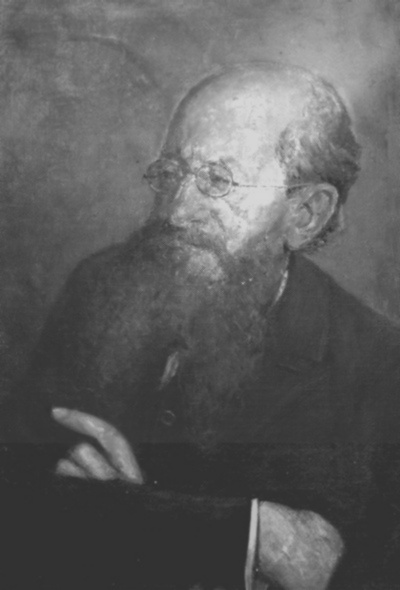 |
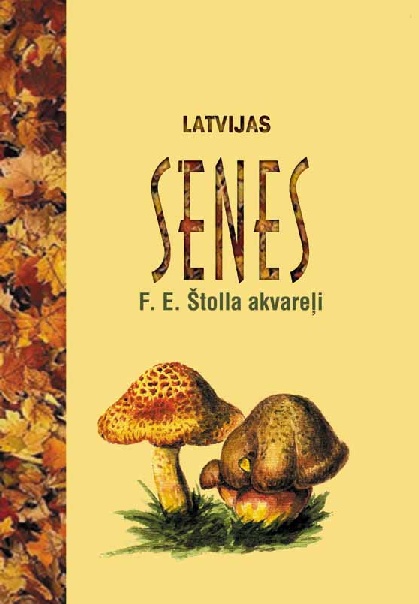 |
|
Fungi water-colours by F.E. Stoll
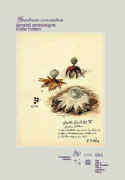 |
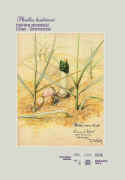 |
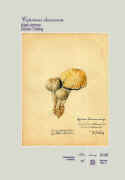 |
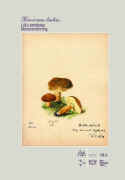 |
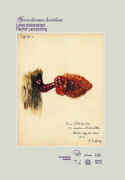 |
 |
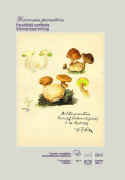 |
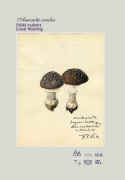 |
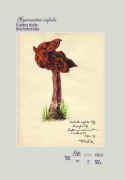 |
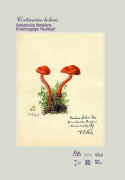 |
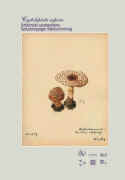 |
 |
 |
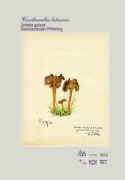 |
 |
Arnolds Amolins' historic
Key of Latvian Russulas
|
|
Key of Russula species found in Latvia by
2005, as compiled (in German) by Arnolds Amolins. |
|
||||||
|
||||||||










